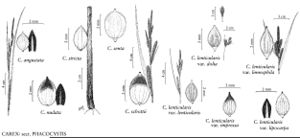Carex lenticularis var. impressa
Syst. Bot. Monogr. 7: 65. 1985.
Basionym: Carex interrupta var. impressa L. H. Bailey Mem. Torrey Bot. Club 1: 18. 1889
Synonyms: Carex limnaea T. Holm Carex paucicostata Mackenzie
Revision as of 20:10, 16 December 2019 by FNA>Volume Importer
Culms 15–60 cm. Leaf blades 2–3.5 mm wide. Inflorescences: peduncle of proximal spike 1 cm; proximal bract red-brown at base, 1–3 mm wide. Spikes: proximal 3–5 spikes pistillate, 1.5–3.6 cm × 3–4 mm; terminal spike staminate. Pistillate scales red-brown or black. Perigynia with purple-brown spots on apical 1/2, 1–3 veins abaxially, ellipsoid or ovoid, 1.8–2.5 × 1.1–1.5 mm; stipe 0.2 mm; beak red-brown, 0.2–0.5 mm. 2n = 92.
Phenology: Fruiting Aug.
Habitat: Seasonally flooded river and lakeshores
Elevation: 1200–3000 m
Distribution

Calif., Idaho, Oreg., Wash.
Discussion
Primarily a taxon of the Sierra Nevada and southern Cascade Mountains, Carex lenticularis var. impressa tends to have smaller perigynia with fewer veins and more red-brown pigmentation than does the more widespread var. lipocarpa.
Selected References
None.
Lower Taxa
None.
